The 10 Best Hamstring Stretches to Relieve Tightness and Boost Flexibility
As a runner, I'm no stranger to tight hamstrings. Between sprints, hills and long hauls on the treadmill, I put my posterior muscles through the wringer just about every week. Dynamic warm-ups and yoga-inspired cool-downs help me maintain flexibility no matter the workout du jour, but more often than not, my high-maintenance hamstrings require a bit more TLC. To make sure I'm incorporating the most effective moves while stretching at home, I reached out to a personal trainer for some expert advice.
Meet the Expert
Natalia Perez-Segnini is a NASM-certified personal trainer, a yoga instructor, a breathwork practitioner and a trauma-informed specialist. As a head coach at Tone House—a premier athletic-based strength and conditioning facility in New York City—Perez-Segnini has dedicated her professional life to helping others better understand themselves through the modalities of movement and breath. She specializes in the mind-body connection and emphasizes the importance of intentional movement with a focus on longevity, enhanced quality of life and nervous system health.
What Are the Hamstrings?
Your hamstrings are made up of three individual muscles (biceps femoris, semimembranosus and semitendinosus) that run along the backs of your thighs to connect your hips to your knees. This muscle group works in tandem to help extend the hip, flex the knee and rotate your lower leg—actions we all do on the reg. From hiking to sitting to walking up the stairs, the hamstrings are involved in almost every move we make. Unfortunately, this means they’re also extremely susceptible to injury.
Caring for your hamstrings involves both strengthening and lengthening, but you can’t max out a deadlift if your muscles are as tight as a rubber band. What’s worse, you could strain or tear them in the process (more on that later). That's why I've rounded up ten of the best hamstring stretches that can be done just about anywhere. When maintained consistently, these stretches will help relieve pain, decrease tightness, increase mobility and even boost strength. Ready for some major relief?
8 Hamstring Exercises You Can Do at Home for Lower-Body Strength and Stability
1. Standing Toe Touch
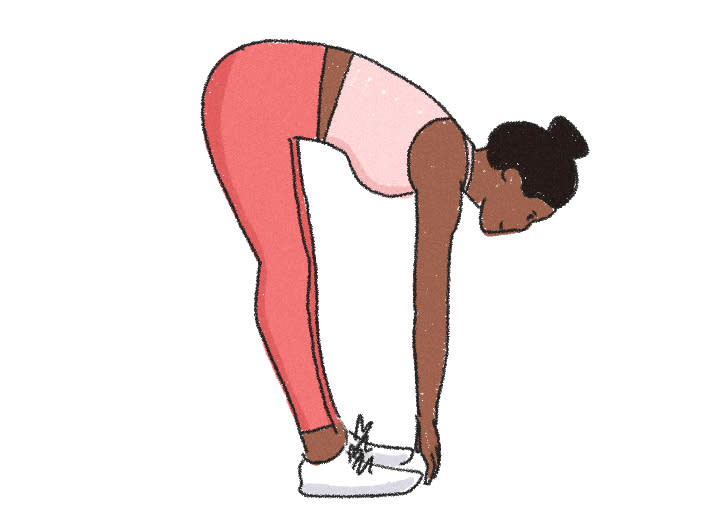
Mckenzie Cordell
Step 1: Stand with your feet hip-width apart. Hinge forward at your hips and reach for your toes with both hands. It’s OK if you can’t touch the ground. Go as far as you can until you feel a slight stretch in the backs of your thighs.
Step 2: As you breathe, try to lower your hands further to the ground deepening the stretch with each exhale.
Step 3: Hold for 15 to 30 seconds. Return to the starting position and repeat.
2. Rotating Toe Touch
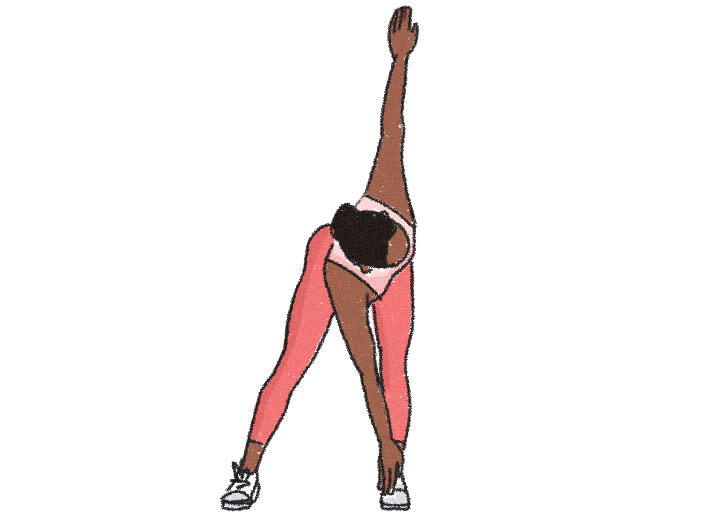
Mckenzie Cordell
Step 1: Stand with your feet wider than hip-width apart with your arms stretched out to your sides at shoulder height.
Step 2: Keeping your legs straight and your arms aligned, twist your torso and extend your right arm down toward your left ankle. You’ll feel this stretch more intensely in the back of your left leg.
Step 3: Hold for 15 to 30 seconds. Return to the starting position and repeat on the opposite side.
3. Standing Hamstring Stretch
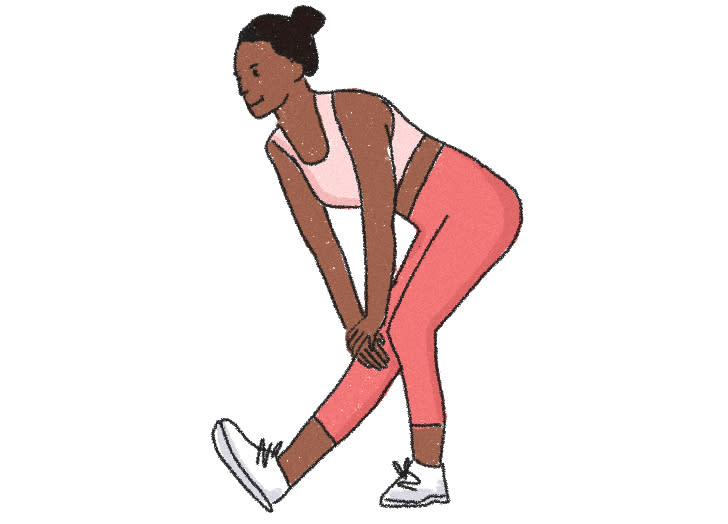
Mckenzie Cordell
Step 1: Stand with your feet hip-width apart. Place your right heel in front of your body with your foot flexed, toes pointing up. Put a slight bend in your left knee.
Step 2: Slowly lean forward and place your hands on your right thigh or calf until you feel a stretch in the back of your leg.
Step 3: Hold for 15 to 30 seconds. Return to the starting position and repeat on the opposite side.
4. Extended Triangle Pose
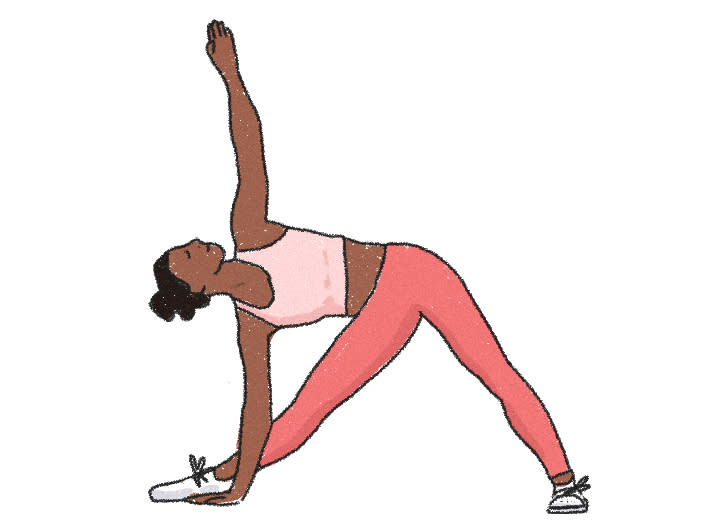
Mckenzie Cordell
Step 1: Stand with your feet hip-width apart. Step your right leg out to the side while shifting your foot so your toes are facing out as well.
Step 2: Stretch your arms out to your sides at shoulder height. Shift your torso to the right and extend down reaching your right arm towards the ground either in front of or behind your foot, depending on your flexibility.
Step 3: Hold for 15 to 30 seconds. Return to the starting position and repeat on the opposite side.
5. Lunging Hamstring Stretch
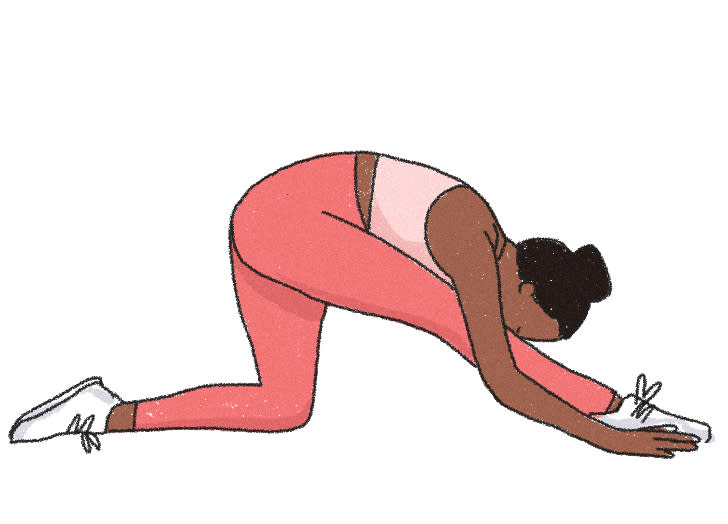
Mckenzie Cordell
Step 1: Stand with your feet hip-width apart. Lunge forward with your right leg and lower until your back knee hits the ground.
Step 2: With your back knee bent, gently straighten your right leg keeping your hips square and fold forward until you feel a stretch in your hamstring.
Step 3: Hold for 15 to 30 seconds. Return to the starting position and repeat on the opposite side.
6. Seated Hamstring Stretch
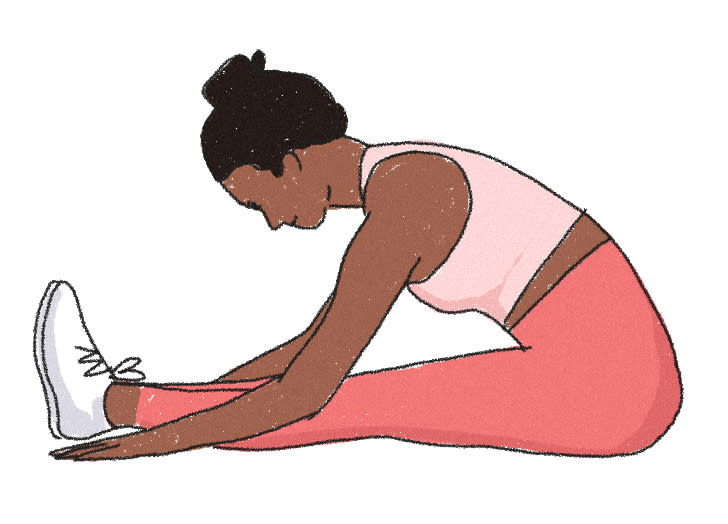
Mckenzie Cordell
Step 1: Sit with both legs extended out straight in front of you.
Step 2: Keeping your spine long, fold forward and reach both arms in front of you until you feel a stretch in the back of your legs. Make sure both legs remain fully on the ground.
Step 3: Hold for 15 to 30 seconds. Return to the starting position and repeat.
7. Seated Single-leg Hamstring Stretch
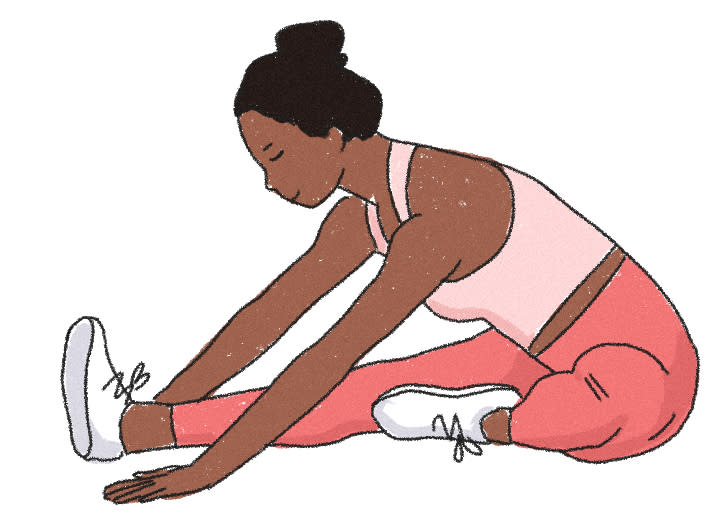
Mckenzie Cordell
Step 1: Sit with your right leg extended out straight and your left leg bent so the sole of your foot rests on the inner thigh of your right leg.
Step 2: Keeping your spine long, fold forward and reach both arms toward your right foot until you feel a stretch in the back of your leg. Make sure your straight leg remains fully on the ground.
Step 3: Hold for 15 to 30 seconds. Return to the starting position and repeat on the opposite side.
8. Seated Wide-leg Hamstring Stretch
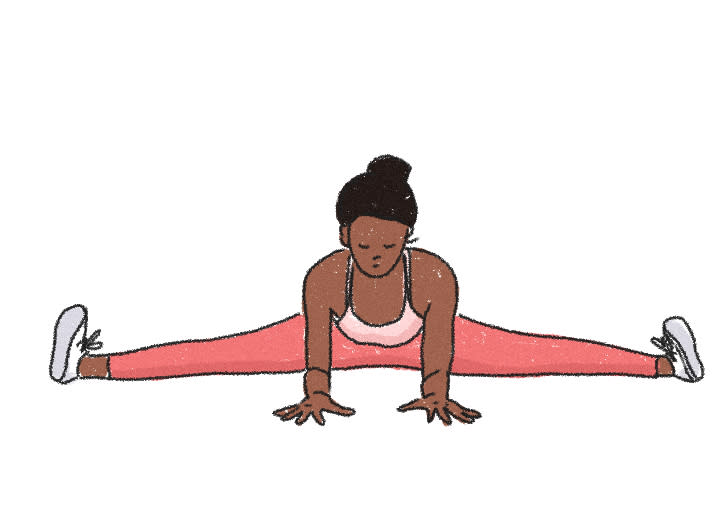
Mckenzie Cordell
Step 1: Sit down with your legs extended out wide in opposite directions.
Step 2: Keeping your spine long, fold forward and reach both arms forward until you feel a stretch in the back of your legs. Make sure both legs remain fully on the ground. With each exhale, try to crawl your hands out a little further to deepen the stretch.
Step 3: Hold for 15 to 30 seconds. Return to the starting position and repeat.
9. Downward Facing Dog
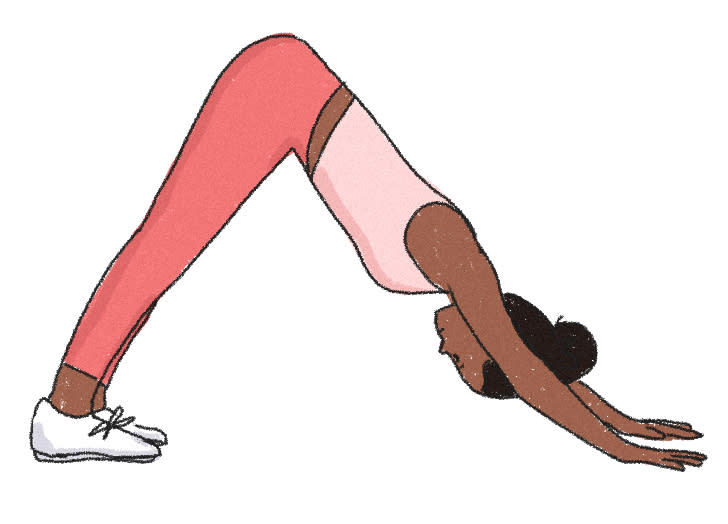
Mckenzie Cordell
Step 1: Begin in a plank position with your feet together and hands directly below your shoulders.
Step 2: Press back into your heels sending your head and chest through your arms while your butt lifts up toward the sky.
Step 3: Keep your head, neck and spine aligned as you press back feeling the stretch in the backs of your legs (this will stretch out your calves as well). Peddle out your feet to deepen the stretch.
Step 4: Hold for 15 to 30 seconds. Return to the starting position and repeat.
10. Lying Hamstring Stretch With Band

Mckenzie Cordell
Step 1: Lie on your back with a resistance band or towel wrapped around your right foot. If you don’t have one, you can use your hands to pull back on your thigh instead.
Step 2: Slowly stretch your right leg up, keeping the opposite leg flat on the floor and both knees straight.
Step 3: Extend as far as you can go until you feel a stretch in the back of your right leg.
Step 4: Hold for 15 to 30 seconds. Return to the starting position and repeat on the opposite side.
What Are the Benefits of Hamstring Stretches?
Improved movement patterns overall
Increased mobility
Increased range of motion
Enhanced joint health
Improved athletic performance
Better neuromuscular (mind-body) connection
Improved quality of life through movement
What Are the Symptoms of Tight Hamstrings?
"Tight hamstrings can be the cause of many uncomfortable feelings in the body," Perez-Segnini explains, "with one of the main symptoms being poor mobility." If you're unsure if your hamstrings are tight, try a flexibility test (I promise, it’s easier than it sounds). Can you touch your toes? How far down can you go and how does the farthest point feel? Do you have any sharp, shooting pain or is the sensation dull and manageable? Answering these questions will help you gauge your current flexibility. In this case, a dull sensation is normal. It just means the fibers in your muscles and connective tissue are beginning to lengthen. A sharp, shooting pain, on the other hand, could be the result of a muscle strain or injury caused by tight hamstrings.
Because of their physiological location, tightness in the hamstrings can start a domino effect of adverse reactions in the body due to muscular imbalances. Suddenly, that twinge in the back of your knee radiates up into your lower back, and then out of nowhere, your hip flexor seizes up. These are all symptoms of tight hamstrings. Because the hamstring is attached to your pelvis as well as your knee (which then attaches to your foot), any shortening of the muscle due to tightness can cause pulling on your hips and tendons leading to achy knees, bothersome backs, plantar fasciitis and (oof) sciatica pain.
What Causes Tight Hamstrings?
More often than not, poor stretching (or none at all) before and after a workout is the main cause of tight hamstrings, but even if you’re not hitting the gym twice a week, you can still experience similar symptoms. Observe your body throughout the day. Are you glued to a desk from nine to five? Sitting for extended periods of time can create similar symptoms to exercise-induced tightness by shortening and weakening the hamstring. This shortening results in tighter muscles that are unable to extend properly during exercise (which is why you feel that pain post-workout).
Another culprit of tight hamstrings could be weakness or inefficiencies in other surrounding muscle groups, like the hip flexors and glutes. "The hamstrings are responsible for some pretty big movements," Perez-Segnini says. "So when smaller surrounding muscle groups aren’t engaging and firing properly, the hamstrings can tap themselves into the fight to take the path of least resistance," the body’s methodology for life. "This can lead to over-usage and chronic tightness."
What Can I Do to Prevent Tight Hamstrings?
"If you're experiencing tightness, stretching and mobility work can be your best friend," Perez-Segnini says, "but strengthening your hamstrings and the surrounding muscle groups," like the quads, hip flexors, glutes and abdominals, "is just as important." She suggests starting with just five minutes a day dedicated to exploring your mobility and moving intuitively. "Integrating a daily routine of gentle movement," like this list of stretches, "to lengthen and strengthen the hamstrings is a great place to start." Bottom line: Both stretching and strengthening are vital to maintaining healthy hamstrings.
9 Stretches to Do Before Bed for the Best Sleep of Your Life

